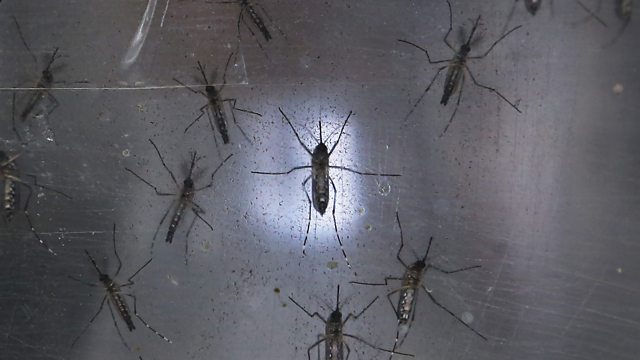Zika Virus: What Do We Know?
What do we know about the Zika virus and how can we find out more? Cold weather in East Asia; New Antibiotic test; Tracking Jupiter on clay tablets.
Since October 2014 almost 4000 babies have been born in Brazil with underdeveloped brains and smaller heads. Although not proven, doctors suspect that infection with the Zika virus during pregnancy is causing these abnormalities. The virus is spreading at an alarming rate across South and Central America and the WHO has warned that all the Americas are at risk of the virus. The symptoms seem fairly mild – a flu like illness, sometimes with soreness of the eyes, yet it appears to have devastating consequences on the developing foetus. Some areas have declared a state of emergency, doctors have described it as "a pandemic in progress" and some are even advising women in affected countries to delay getting pregnant. Prof Jonathan Ball tells us about the virus and its spread while Prof Trudie Lang on what science can do; she runs neglected tropical clinical trials in developing countries.
Cold Weather in East Asia
An unusually cold weather front coming from the North Pole brought temperatures to record lows in many parts of East Asia over the past week. Heavy snow storms caused at least five deaths in Japan. Hundreds of flights were cancelled in South Korea, leaving tens of thousands of passengers stranded. Hong Kong and South China were also hit. Reports link the weather to at least 85 deaths in Taiwan from hypothermia and cardiac disease – temperatures there were the lowest in 44 years and most homes do not have heating. Cindy Sui, our Taipei correspondent tell us more.
New Antibiotic Test
New results have come out from a paper which may provide a test for dealing with the problem of antibiotic misuse. The test takes a novel approach to determining whether respiratory infections are caused by bacteria or viruses or something else. Currently the approach is to look for the pathogen causing the infection. However this new research suggests that it might be more accurate to look at the host response as opposed to the pathogen. Here today we have professor Chris Woods from Duke University, author of this new paper, to discuss the implications of this new blood test and whether it could be used across the globe.
Tracking Jupiter on Clay Tablets
New research shows that Babylonians were able to model the pathway of Jupiter using geometry between 350-50BC. The ability of humans to do this was previously thought to be around 1400 AD by the work of Astronomers in Oxford and Paris. Dr. Mathieu Ossendrijver, who is trained in both astrophysics and the cuneiform writing system used by the Babylonians, made the discovery.
(Photo: Aedes aegypti mosquitos © Mario Tama/Getty Images)
Last on
More episodes
Previous
Broadcasts
- Thu 28 Jan 2016 20:32GMT����ý World Service UK DAB/Freeview, Online, Europe and the Middle East & Americas and the Caribbean only
- Thu 28 Jan 2016 21:32GMT����ý World Service West and Central Africa, Australasia, East Asia & South Asia only
- Fri 29 Jan 2016 02:32GMT����ý World Service Americas and the Caribbean
- Fri 29 Jan 2016 03:32GMT����ý World Service Online, East Asia, Europe and the Middle East & UK DAB/Freeview only
- Fri 29 Jan 2016 04:32GMT����ý World Service South Asia
- Fri 29 Jan 2016 05:32GMT����ý World Service Australasia
- Fri 29 Jan 2016 07:32GMT����ý World Service East and Southern Africa & Europe and the Middle East only
- Fri 29 Jan 2016 13:32GMT����ý World Service Online & UK DAB/Freeview only
- Fri 29 Jan 2016 14:32GMT����ý World Service East and Southern Africa, East Asia, Europe and the Middle East, South Asia & West and Central Africa only
Podcast
-
![]()
Science In Action
The ����ý brings you all the week's science news.


